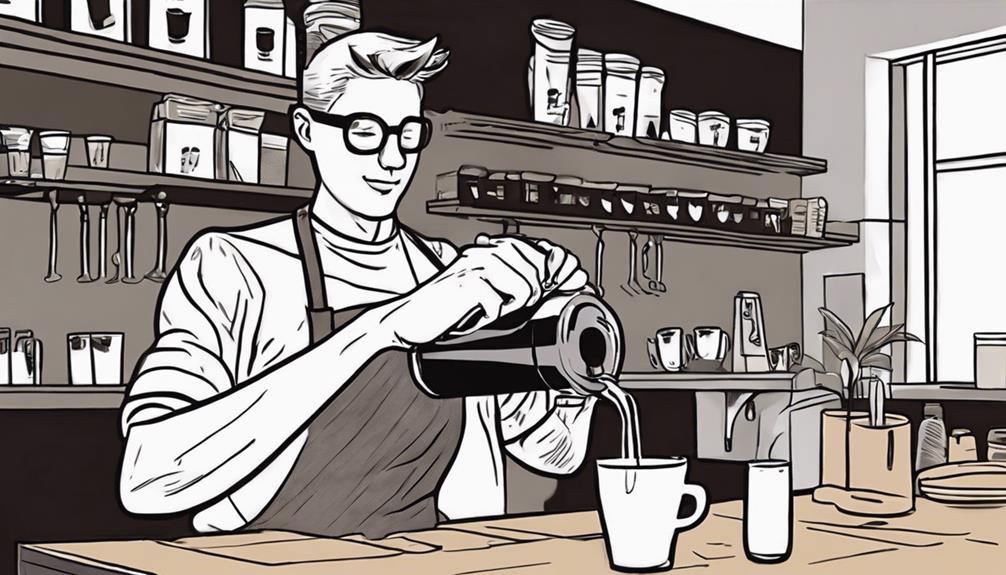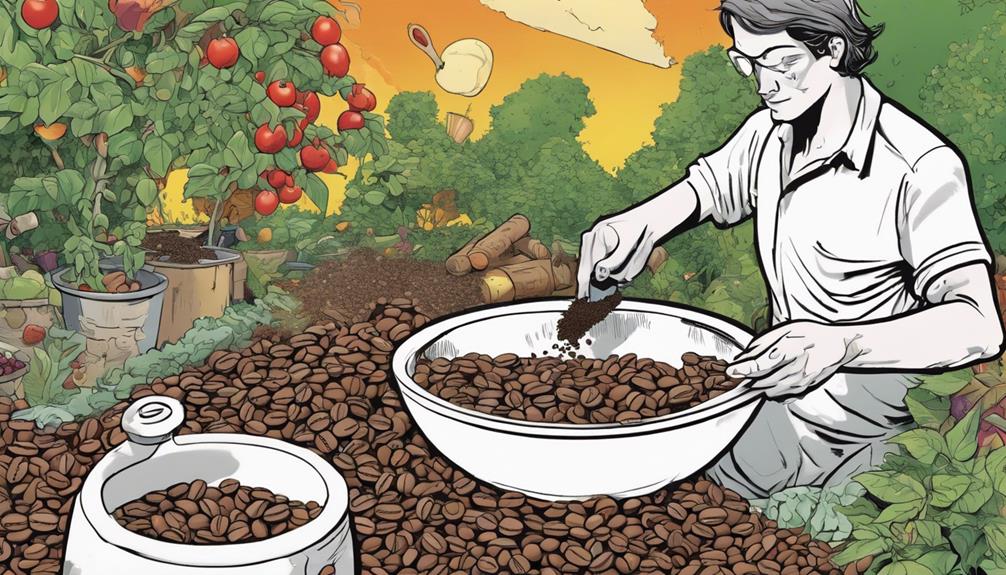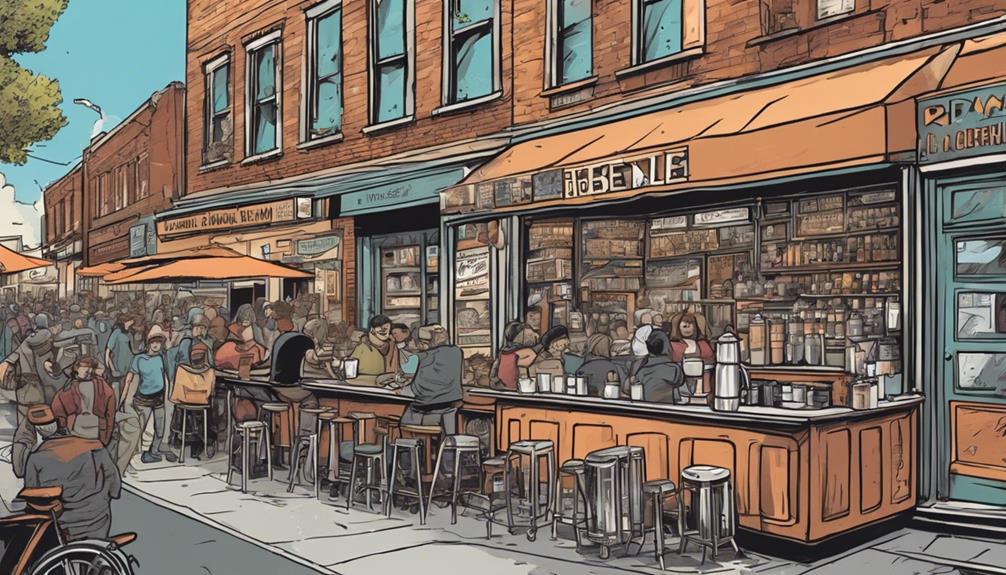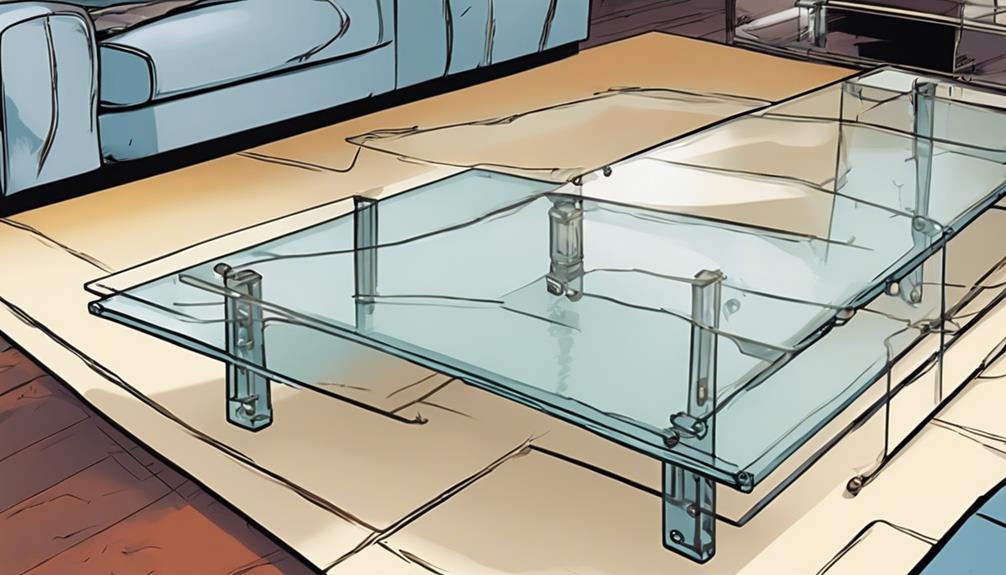Looking to enjoy your coffee without sugar but still want it sweet and smooth? Consider using natural sweeteners like agave syrup or stevia for a healthier option. Enhance the flavor by adding cinnamon or lavender, or try experimenting with fruity additions such as ripe fruit purees. Creamy alternatives like coconut or almond milk can also elevate your coffee experience. For a unique twist, think about using unconventional sweeteners like hibiscus tea or cranberry juice. Boost the taste of your coffee with vanilla extract or citrus zest. Another option is hazelnut creamer for a sweet and smooth taste without added sugar. Give these tips a try for a delicious coffee experience!
Key Takeaways
- Use natural sweeteners like agave syrup or stevia for sweetness without sugar.
- Enhance flavor with spices like cinnamon or herbs like mint for a smooth taste.
- Try creamy options like vanilla or coconut creamers for a sweet and smooth coffee.
- Experiment with unconventional sweeteners like salt or butter for unique flavors.
- Add fruit purees or citrus zest for natural sweetness and a smooth coffee experience.
Natural Sweeteners for Coffee
Explore a variety of natural sweeteners that can enhance the flavor of your favorite coffee without the need for sugar. When it comes to types of coffee, incorporating natural sweeteners can elevate your coffee experience.
Agave syrup, known for its lower glycemic index, is a popular choice to sweeten your daily brew without the drawbacks of refined sugars. Stevia, derived from the Stevia rebaudiana plant, is a calorie-free option that packs a powerful sweet punch, requiring only a small amount to make your coffee just right.
Maple syrup, with its rich, caramel-like sweetness, not only adds flavor but also brings in antioxidants and essential minerals like manganese and zinc to your morning cup.
Monk Fruit sweetener, being 100-250 times sweeter than sugar and zero-calorie, is a fantastic choice for those aiming to cut down on sugar intake without compromising on taste. Additionally, coconut sugar, with its subtle caramel notes and lower glycemic index, offers a delightful alternative to regular sugar in your daily coffee ritual.
Spices and Herbs Flavor Boost

Enhance the flavor of your coffee without sugar by introducing a variety of spices and herbs for a delightful taste experience.
Cinnamon is a popular choice, adding a warm and slightly sweet flavor profile to your coffee.
Lavender offers a unique twist with its floral and aromatic notes, creating a soothing drinking experience.
If you're looking for a revitalizing kick, consider adding mint leaves to your coffee for a cool and invigorating taste.
For a touch of subtle sweetness and relaxation, chamomile can be a great addition to your brew.
To conclude, cardamom brings a rich and exotic flair to your coffee, thanks to its spicy and citrusy undertones.
Experiment with these spices and herbs to elevate your coffee game and enjoy a flavorful cup without the need for sugar.
Fruit Additions for Sweetness

Adding ripe fruit purees or citrus zest to your coffee can naturally sweeten and enhance its flavor profile without the use of sugar.
Juicy fruit purees like raspberry or peach bring a natural sweetness and fruity twist to your brew.
Citrus zest from lemon or orange offers a zesty, invigorating kick that livens up your cup without added sugar.
If you prefer a chewy texture, try tossing in some dried fruit bits like cranberries or apricots for a subtle sweetness.
For an extra burst of fruity flavor, consider drizzling fruit syrups such as strawberry or blueberry into your coffee.
Alternatively, adding fruit juices like apple or pomegranate can introduce a sweet and tangy element to your morning drink.
Experiment with these fruit additions to find the perfect balance of sweetness and flavor in your coffee without relying on sugar.
Creamy Alternatives for Coffee
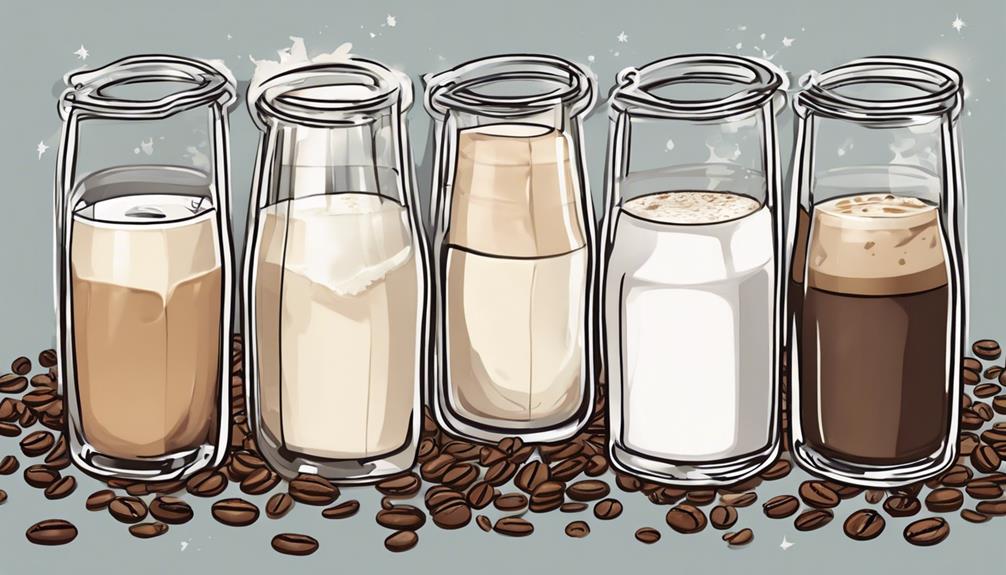
Discover a world of creamy alternatives for your coffee – from classic vanilla to exotic coconut flavors.
Explore dairy-free options that cater to different dietary needs and preferences.
Infuse your coffee with richness and depth using a variety of flavorful creamers.
Creamer Variety Breakdown
You can elevate your coffee experience with a diverse selection of creamers that offer rich and flavorful alternatives to sugar. Here's a breakdown of some creamer varieties that can enhance the taste of your daily cup of coffee:
| Creamer Variety | Description |
|---|---|
| Vanilla | Adds a rich and creamy vanilla flavor to your coffee |
| Coconut | Dairy-free and naturally sweet option |
| Hazelnut | Nutty and flavorful alternative enhancing coffee taste |
| Caramel | Sweet and indulgent caramel flavor without additional sugar |
These creamers provide a range of options to suit different preferences, whether you prefer a nutty twist with hazelnut or a sweet treat with caramel. Each creamer brings its unique essence to your coffee, ensuring you enjoy every sip without the need for sugar. Experimenting with these creamer varieties can transform your daily coffee routine into a delightful experience.
Dairy-Free Alternatives
Dairy-free creamer options, such as almond creamer, coconut creamer, and oat milk creamer, offer a creamy texture without using dairy products. Each one brings a unique flavor profile to your coffee without compromising on creaminess. Almond creamer provides a nutty undertone, coconut creamer adds a touch of the tropics, and oat milk creamer offers a hint of sweetness.
These non-dairy alternatives cater to individuals with lactose intolerance or dietary restrictions, ensuring everyone can enjoy a smooth cup of coffee without the need for traditional dairy products.
One that's craving a richer taste can also experiment with adding a sprinkle of cocoa powder to their coffee without sugar. This simple addition can elevate the flavor profile of your beverage, creating a decadent treat without the need for added sweetness.
Flavorful Infusions
For a delightful twist in your daily cup of coffee, consider incorporating flavorful infusions like vanilla, hazelnut, caramel, almond, or coconut creamers for a creamy and sweet experience without sugar. These creamers come in a variety of dairy and non-dairy options, catering to different dietary preferences.
Vanilla creamer adds a classic and smooth sweetness to your coffee.
Hazelnut creamer imparts a nutty and rich flavor for a unique taste.
Caramel creamer provides a sweet and indulgent experience without the need for sugar.
Almond creamer offers a nutty undertone, adding a twist to your coffee.
Coconut creamer brings a tropical essence, enhancing the creaminess of your coffee.
Experimenting with different flavored creamers can help you find the perfect balance of sweetness and creaminess in your coffee, allowing you to enjoy a flavorful cup without the added sugar.
Unconventional Coffee Sweeteners Guide

Enhance your coffee experience with these unconventional sweeteners that can elevate your brew without the need for sugar.
Salt, often seen as a savory ingredient, can surprisingly reduce bitterness in coffee and enhance its natural sweetness.
Butter, when blended in, adds a creamy texture and a rich, indulgent flavor, making it a decadent alternative to sugar.
For a subtle sweetness and a complex aroma, try adding a dash of vanilla extract to your coffee.
Hibiscus tea brings a floral and slightly tangy note that complements coffee's flavors without overpowering them.
If you're looking for a fruity twist, consider mixing in a small amount of cranberry juice to add a tart balance to the bitterness.
These unconventional sweeteners offer a unique way to enjoy your coffee without the added sweetness of sugar, allowing you to savor the natural flavors in each cup.
Enhancing Coffee With Agave Syrup

Using agave nectar to sweeten your coffee can provide a natural and flavorful alternative to refined sugar. Agave nectar, derived from the agave plant, offers a variety of benefits that make it a great choice for enhancing your coffee-drinking experience:
- Lower Glycemic Index: Helps prevent blood sugar spikes and crashes.
- Increased Sweetness: Requires less nectar to achieve desired sweetness levels.
- Mild Flavor: Complements, rather than overpowers, the taste of your coffee.
- Versatile: Can be used in hot or cold coffee due to its liquid form.
- Easy Dissolvability: Guarantees even sweetness distribution throughout your drink.
Elevating Flavor With Vanilla Extract

Elevate your coffee's flavor profile by incorporating a touch of aromatic vanilla extract.
This popular and versatile flavoring agent can enhance the taste of your coffee without the need for sugar. With just a small amount, vanilla extract adds a rich and aromatic dimension to your brew, providing a sweet and smooth flavor profile.
Derived from the vanilla bean, this extract contains natural compounds that contribute to its unique and pleasant taste. By adding vanilla extract to your coffee, you can create a comforting and indulgent experience, making your daily cup more enjoyable.
Vanilla extract pairs well with various coffee types and blends, offering a simple yet effective way to elevate the flavor of your favorite brew.
Citrus Zest for Freshness
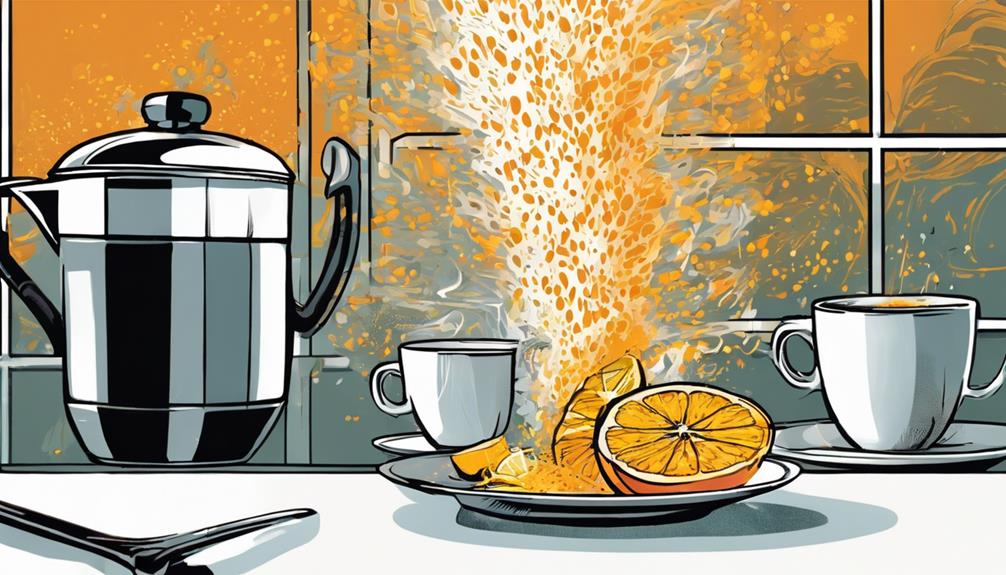
You can enhance the freshness of your coffee by incorporating citrus zest, like lemon or orange, into your brew.
The zesty flavor burst and citrus aroma boost will elevate your coffee experience without the need for added sugar.
Experiment with different types of citrus zest to find the perfect balance of sweetness and tanginess that suits your taste preferences.
Zesty Flavor Burst
To infuse your coffee with a vibrant burst of invigorating zing and acidity, consider adding citrus zest like lemon or orange. The essential oils in citrus zest provide a natural aroma that complements the rich flavors of coffee.
Simply grate the outer colored part of the citrus peel to add a tangy twist to your cup of coffee. Citrus zest is a low-calorie and sugar-free way to enhance the flavor profile of your coffee without adding sweetness.
Experiment with different citrus fruits to find your favorite flavor combination with coffee.
- Vibrant Invigoration: Citrus zest adds a burst of invigoration to your coffee, awakening your senses.
- Natural Aroma: The essential oils in citrus zest create a delightful aroma that pairs well with the robust notes of coffee.
- Simple Preparation: Grate the colorful outer layer of citrus peels to effortlessly infuse your coffee with zesty flavors.
- Healthy Flavor Enhancement: Citrus zest is a calorie-free option to elevate your coffee's taste without sugar.
- Flavor Exploration: Try various citrus fruits like lime or grapefruit to discover unique and revitalizing combinations for your coffee.
Citrus Aroma Boost
Adding citrus zest to your coffee introduces a burst of invigorating aroma and vibrant flavor, enhancing your morning brew without the need for sugar. The natural oils in citrus zest provide a revitalizing aroma boost that elevates the overall sensory experience of your coffee.
Popular choices like lemon, orange, and grapefruit zest offer a zesty twist to your daily cup of joe. To incorporate this rejuvenating touch, simply grate the outer colored part of the citrus fruit to extract the flavorful zest, infusing your coffee with a low-calorie, sugar-free essence.
Citrus zest not only adds a bright and tangy flavor to your coffee but also contributes to a delightful aromatic profile that awakens your senses. By incorporating citrus zest into your coffee routine, you can enjoy an invigorating and flavorful brew that tantalizes your taste buds and uplifts your mornings without relying on sugar for sweetness.
Creamy Delights With Hazelnut Creamer

Indulge in creamy delights by incorporating hazelnut creamer into your coffee for a rich and nutty flavor experience. Hazelnut creamer is a popular non-dairy alternative that adds a luxurious touch to your daily cup of joe.
Here are some key points about hazelnut creamer:
- Made with hazelnut extract, sugar, and a creamy base like almond or coconut milk, hazelnut creamer offers a delightful combination of flavors.
- Whether in liquid or powder form, this creamer is convenient for use at home or on the go, allowing you to enjoy a delicious cup of coffee anywhere.
- Hazelnut creamer provides a sweet and smooth taste to your coffee without the need for additional sugar, making it a healthier choice.
- Coffee shops often offer hazelnut creamer as an option, giving you the opportunity to elevate the taste of your favorite coffee beverages.
- With hazelnut creamer, you can transform your ordinary coffee into a delightful and indulgent treat that will satisfy your cravings for a creamy and nutty flavor profile.
Unique Twist: Coffee With Salt
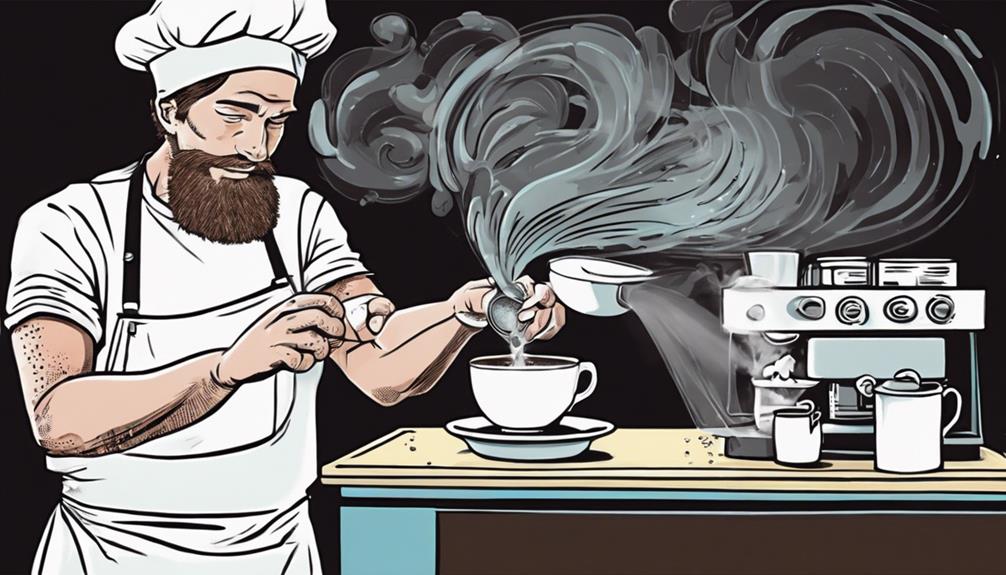
Enhance your coffee's flavor profile with a unique twist by incorporating a pinch of salt into your brew. The addition of salt can work wonders in reducing the bitterness often associated with coffee, while simultaneously bringing out its natural sweetness. By blocking some bitter receptors on your tongue, salt helps to balance the taste of your coffee, creating a delightful harmony of flavors. Experiment with different types of salt like sea salt or Himalayan pink salt to discover the ideal balance that suits your palate. Just a small amount of salt can elevate your coffee experience, offering a savory twist to your daily cup of joe.
| Benefits of Adding Salt to Coffee | Emotions Evoked |
|---|---|
| Enhances flavor profile | Curiosity |
| Reduces bitterness | Intrigue |
| Highlights natural sweetness | Excitement |
Frequently Asked Questions
How to Make Beaten Coffee Without Sugar?
To make beaten coffee without sugar, you can use natural sweeteners like agave syrup or monk fruit. Experiment with flavored creamers such as vanilla or hazelnut. Add spices like cinnamon for extra flavor. Try fruit additions too! Staying energized naturally is important for many people, and avoiding the added sugar in traditional beaten coffee can be a good way to do that. By using natural sweeteners and flavorings, you can create a delicious and satisfying beverage without the crash that comes from excessive sugar intake. Experiment with different combinations until you find the perfect recipe for your own unique taste preferences while staying energized naturally.
How Do You Make Coffee Taste Sweet Without Sugar?
You want your coffee sweet without sugar? Get creative! Try natural sweeteners like agave syrup or honey. Spice it up with cinnamon or cardamom. Add a twist with fruit purees or flavored creamers. Experiment and enjoy! For a decadent treat, consider trying out different coffee syrup recommendations such as vanilla, caramel, or hazelnut. These flavored syrups can add a delicious depth of flavor to your coffee without the need for sugar. You can also explore alternative milk options like almond or oat milk for a creamy and naturally sweet addition to your coffee. Let your imagination run wild with all the possibilities for a delicious and unique sweet coffee experience!
What Can I Use to Sweeten My Coffee if I Don't Have Sugar?
If you don't have sugar for your coffee, try sweetening it with alternatives like agave syrup, stevia, vanilla extract, coconut sugar, or monk fruit. These options can add a touch of sweetness without using traditional sugar.
How Do You Tolerate Coffee Without Sugar?
To tolerate coffee without sugar, start by gradually reducing sugar and trying natural sweeteners like agave or stevia. Enhance flavor with spices or fruit purees. Use flavored creamers for sweetness. Experiment to find what works best for you.
Conclusion
Next time you reach for your cup of coffee, remember that there are plenty of ways to enjoy it without adding sugar. Some people enjoy their coffee black, while others opt for alternative sweeteners like stevia or agave. Additionally, you can also explore natural energy boost techniques to help you kickstart your day, such as getting regular exercise, staying hydrated, and eating a balanced diet with plenty of fruits and vegetables. By incorporating these habits into your routine, you can enjoy the benefits of coffee without relying on added sugar for an energy boost.
Whether you opt for natural sweeteners, flavorful spices, or creamy alternatives, there are endless possibilities to elevate your coffee experience.
So go ahead, try something new and embrace the sweet and smooth flavors of your favorite drink without the need for sugar. Your taste buds will thank you!
